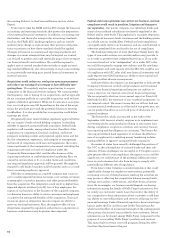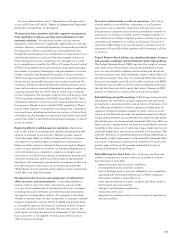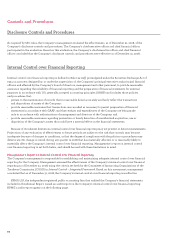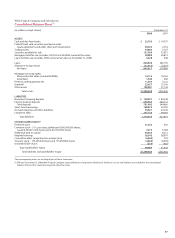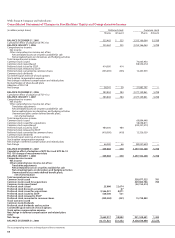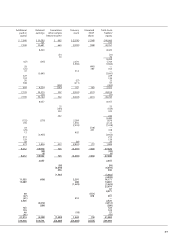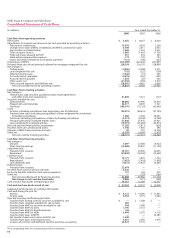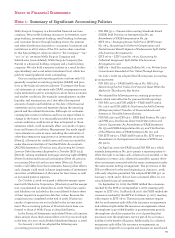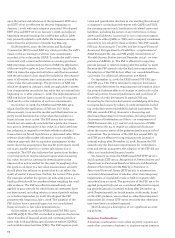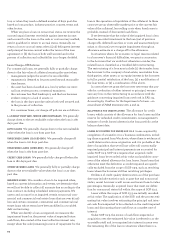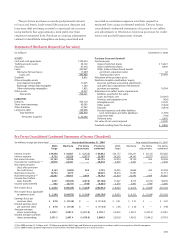Wells Fargo 2008 Annual Report Download - page 94
Download and view the complete annual report
Please find page 94 of the 2008 Wells Fargo annual report below. You can navigate through the pages in the report by either clicking on the pages listed below, or by using the keyword search tool below to find specific information within the annual report.upon the nature and substance of the agreement. EITF 06-4
and EITF 06-10 are effective for the year beginning on
January 1, 2008, with early adoption permitted. We adopted
EITF 06-4 and EITF 06-10 on January 1, 2008, and reduced
beginning retained earnings for 2008 by $20 million (after
tax), primarily related to split-dollar life insurance arrange-
ments from the acquisition of Greater Bay Bancorp.
On November 5, 2007, the Securities and Exchange
Commission (SEC) issued SAB 109, which provides the staff’s
views on the accounting for written loan commitments
recorded at fair value under GAAP. To make the staff’s views
consistent with current authoritative accounting guidance,
SAB 109 revises and rescinds portions of SAB 105, Application
of Accounting Principles to Loan Commitments. Specifically,
SAB 109 states the expected net future cash flows associated
with the servicing of a loan should be included in the measure-
ment of all written loan commitments that are accounted for
at fair value through earnings. The provisions of SAB 109,
which we adopted on January 1, 2008, are applicable to written
loan commitments recorded at fair value that are entered into
beginning on or after January 1, 2008. The implementation of
SAB 109 did not have a material impact on our first quarter
2008 results or the valuation of our loan commitments.
On October 10, 2008, the FASB issued FSP FAS 157-3,
which clarifies the application of FAS 157, Fair Value
Measurements, in an inactive market and illustrates how an
entity would determine fair value when the market for a
financial asset is not active. The FSP states that an entity
should not automatically conclude that a particular transac-
tion price is determinative of fair value. In a dislocated mar-
ket, judgment is required to evaluate whether individual
transactions are forced liquidations or distressed sales. When
relevant observable market information is not available, a
valuation approach that incorporates management’s judg-
ments about the assumptions that market participants would
use in pricing the asset in a current sale transaction is
acceptable. The FSP also indicates that quotes from brokers
or pricing services may be relevant inputs when measuring
fair value, but are not necessarily determinative in the
absence of an active market for the asset. In weighing a bro-
ker quote as an input to a fair value measurement, an entity
should place less reliance on quotes that do not reflect the
result of market transactions. Further, the nature of the quote
(for example, whether the quote is an indicative price or a
binding offer) should be considered when weighing the avail-
able evidence. The FSP was effective immediately and
applied to prior periods for which financial statements have
not been issued, including interim or annual periods ending
on or before September 30, 2008. We adopted the FSP
prospectively, beginning July 1, 2008. The adoption of the
FSP did not have a material impact on our consolidated
financial results or fair value determinations.
On December 11, 2008, the FASB issued FSP FAS 140-4
and FIN 46(R)-8. This FSP is intended to improve disclosures
about transfers of financial assets and continuing involve-
ment with both qualifying special purpose entities (QSPEs)
and variable interest entities (VIEs). The FSP requires quali-
tative and quantitative disclosures surrounding the nature of
a company’s continuing involvement with QSPEs and VIEs,
the carrying amount and classification of related assets and
liabilities, including the nature of any restrictions on those
assets and liabilities; contractual or non-contractual support
provided to either QSPEs or VIEs; and a company’s maximum
exposure to loss related to these activities. This FSP amends
FAS 140, Accounting for Transfers and Servicing of Financial
Assets and Extinguishments of Liabilities – a replacement of
FASB Statement No. 125, and FIN 46 (R), Consolidation of
Variable Interest Entities (revised December 2003) – an inter-
pretation of ARB No. 51. The FSP is effective for reporting
periods (annual or interim) ending after December 15, 2008.
Because the FSP amends only the disclosure requirements,
the adoption of the FSP did not affect our consolidated finan-
cial results. For additional information, see Note 8.
On September 12, 2008, the FASB issued FSP FAS 133-1
and FIN 45-4. This FSP is intended to improve disclosures
about credit derivatives by requiring more information about
the potential adverse effects of changes in credit risk on the
financial position, financial performance and cash flows of
the sellers of credit derivatives. It amends FAS 133,
Accounting for Derivative Instruments and Hedging Activities,
to require disclosures by sellers of credit derivatives, includ-
ing credit derivatives embedded in hybrid instruments. The
FSP also amends FIN 45, Guarantor’s Accounting and
Disclosure Requirements for Guarantees, Including Indirect
Guarantees of Indebtedness to Others – an interpretation of
FASB Statements No. 5, 57, and 107 and rescission of FASB
Interpretation No. 34, to require an additional disclosure
about the current status of the payment/performance risk of
a guarantee. The provisions of the FSP that amend FAS 133
and FIN 45 are effective for reporting periods (annual or
interim) ending after November 15, 2008. Because the FSP
amends only the disclosure requirements for credit deriva-
tives and certain guarantees, the adoption of the FSP did not
affect our consolidated financial results.
On January 12, 2009, the FASB issued FSP EITF 99-20-1,
which amends EITF 99-20, Recognition of Interest Income and
Impairment on Purchased Beneficial Interests and Beneficial
Interests That Continue to Be Held by a Transferor in
Securitized Financial Assets (EITF 99-20),to achieve more
consistent determinations of whether other-than-temporary
impairments of available-for-sale or held-to-maturity debt
securities have occurred. The provisions of the FSP are to be
applied prospectively and are considered effective for report-
ing periods (annual or interim) ending after December 15,
2008. Beginning with our fourth quarter 2008 results, based
on this FSP guidance, we recorded no other-than-temporary
impairment for certain EITF 99-20 securities that otherwise
may have been considered impaired.
The following is a description of our significant account-
ing policies.
Business Combinations
A business combination occurs when an entity acquires net
assets that constitute a business, or acquires equity interests


